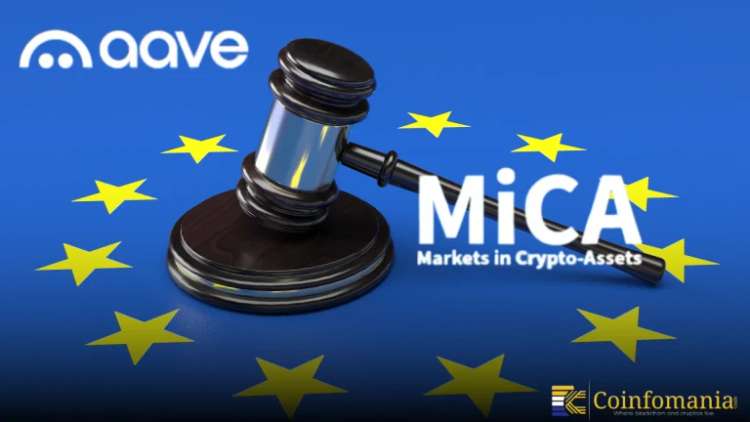AAVE
As of December 15, 2025, Aave (AAVE) is trading at approximately 266.74 USD, reflecting a -3.11% decrease from the previous close.
| Current Price | 24h Price Change | 7-Day Avg Price | Support Level | Next Resistance |
| $266.74 USD | -3.11% | $288.37 USD | $72.96 USD | $393.15 USD |
📈 Technical Analysis Summary
- Price Movement: The -3.11% decrease indicates Bearish pressure; potential uncertainty or profit-taking.
- 7-Day Average Comparison: Trading below the 7-day average ($288.37 USD); weak or consolidating trend; watch for support breakdown.
- Support and Resistance Levels: Price is above support ($72.96 USD); confirms bullish base. Room for growth before hitting resistance ($393.15 USD).
- RSI Analysis: RSI at 42.70 indicates Neutral zone; balanced market.
- MACD Analysis: Negative MACD (-5.44); suggests bearish momentum.
📊 Market Sentiment
| Indicator | Value | Interpretation |
|---|---|---|
| RSI | 42.70% | Neutral; neither overbought nor oversold |
| MACD | -5.44 | Bearish; suggests downward momentum |
| Above 7-Day Avg? | No | Indicates bearish pressure or cooling off |
| Above Support? | Yes | Suggests price stability above support. |
Aave Price Prediction Preview
| Forecast Range | Prediction Trend |
|---|---|
| Daily | 📉 Bearish — Caution in the short term due to weakening indicators |
| Weekly | 🔻 Weak — Risk of short-term pullback if support breaks |
| Monthly | ⚠️ Watch volume — Potential trend exhaustion in AAVEUSD |
| Yearly | 🌐 Long-Term Uptrend — Range between $307–$334 possible by year-end for AAVEUSD |
Related News

Aave Founder Confirms 2026 Relaunch of ETHLend
Aave founder Stani Kulechov surprised the DeFi community by announcing that ETHLend. The original peer-to-peer lending protocol that eventually evolved into Aave will return in 2026. The update sparked excitement among early crypto users who still remember the project’s 2017 roots. The major pivot that reshaped the lending landscape. Stani Highlights Real Bitcoin Collateral Stani […]
Shweta Chakrawarty
Author

Aave Makes Euro Stablecoins Fully Legal Across Europe
Triparna Baishnab
Author

Aave Gains EU MiCA Approval as Push Introduces Zero-Fee Stablecoin Ramps
Vandit Grover
Author

DeFi Lending Surges as Total Value Locked Hits Record $55.99B
Emmmaculate Araka
Author

Aavechan Founder Marc Zeller Previews Aave Umbrella Upgrade in 3 Days, Featuring High Yields and Auto Bad Debt Management
Mikaeel
Author
Aave sets up a system to let people securely lend and borrow crypto with direct transactions. ETHLend launched this project in 2017 with the Aave name in 2018 and now supports Ethereum Avalanche and Polygon blockchains. AAVE functions as the main token to manage user rewards and boost participation through staking. The platform Aave attracts users with its flash loan functions and presents an effective solution to replace standard banking frameworks. Users of Aave should evaluate both the uncertainty of financial markets and authorities' rules.
How Does Aave Work?
The interest is earned by users who deposit crypto assets into liquidity pools. Loans can be taken out by borrowers by depositing overcollateralized deposits. The supply and demand of interest rates dynamically adjust. Flash loans enable users to temporarily take assets from the protocol without any security deposit on condition that funds return to the platform during a single blockchain transaction.
AAVE token owners vote on proposals to manage protocol operations through decentralized autonomous organizations known as DAOs. Aave works across multiple chains to provide better services and support worldwide scaling.
Aave and Other Cryptocurrencies
Aave operates differently from other DeFi platforms, including Compound and MakerDAO according to specific points. Aave creates stablecoins yet offers several token types with different rate settings for lending. Users on Aave have the option to select between variable and stable interest rates because compound offers only one adjustable rate.
In addition, Aave does well in terms of total value locked (TVL), usually being among the top DeFi platforms. One of the most versatile protocols in the DeFi landscape is its support of multiple blockchains and non-collateralized lending tools.
Technology Behind Aave
Aave is built on Ethereum smart contracts written in Solidity that automate all lending and borrowing functions via decentralized code. The protocol utilizes oracles such as Chainlink for providing real-time price data and reducing risk. Aave V3 upgrade brought in gas optimization, cross-chain capability and better liquidation mechanisms.
Aave is a high priority on security—Aave undergoes regular audits and has a risk framework for protocol parameters and asset listings. By staking AAVE into the Safety Module, it further secures the network by insuring against shortfalls.
Is Aave a Good Investment?
As of May 2025, AAVE trades around $175.24, with a market cap of $2.64 billion and a daily trading volume of $186 million. The utility in governance, staking and protocol functionality supports long-term demand. High TVL and cross-chain expansion signal robust growth.
However, risks remain. The price of AAVE dropped by 73% below its greatest historical price without showing any stability. Investing in AAVE carries great potential but also significant risks due to vulnerable smart contracts along with industry rivals and emerging business rules worldwide. Effective investments rely on spreading money across different options while taking proper steps to make choices.
Legal and Regulatory Considerations 2025
Officials have not yet decided if they should treat Aave and other DeFi protocols as fully regulated entities. Front-end providers who interact with Aave need to follow the new EU Markets in Crypto-Assets rules that now govern crypto-asset service providers. The US Securities and Exchange Commission and Commodity Futures Trading Commission check if governance tokens, including AAVE, qualify as securities.
Aave functions as a decentralized platform, but users and financial institutions must adhere to Know Your Customer and Anti-Money Laundering rules and report personal taxes to legal authorities." Aave needs to focus its growth strategy on North America and Europe, while also gaining a better understanding of how laws will affect its operations.
How to Buy and Trade Aave?
To buy AAVE:
- Register on cryptocurrency exchanges Binance, Coinbase, or Kraken to buy AAVE.
- Put funds into your account either through regular money or digital currency types like USD or Bitcoin and Ether.
- Users may buy Aave through the AAVE-USDT or AAVE-ETH trading pairs.
- Transfer to Wallet: It is safer to transfer your AAVE from the exchange to a private wallet.
AAVE can be traded on spot, margin, and derivatives platforms. Always take fees, liquidity and security into consideration when trading.
Aave Wallets and Security
AAVE is an ERC-20 token that can be stored in a variety of wallets.
- Hardware Wallets: Ledger Nano X and Trezor offer cold storage.
- Software Wallets: MetaMask, Trust Wallet, and Coinbase Wallet support AAVE and DeFi interaction.
Strong passwords, 2FA, secure backup of seed phrases and avoiding phishing attacks are security best practices. Wallet software should always be updated, and you should never keep large amounts on centralized exchanges.
How to Secure Your Aave Holdings?
Besides wallet security, DeFi users also need to protect themselves from liquidations during market downturns. To avoid forced liquidations, borrowers should overcollateralize and monitor price feeds. Keep an eye on Aave’s protocol changes via the official blog and Discord and use alerts and analytics dashboards.
Smart contract updates, community proposals and third-party integrations should also be monitored by stakeholders to manage evolving risks.
Aave Adoption and Use Cases
Aave’s flexibility and innovation has made it widely adopted. Major use cases include:
- Lending and Borrowing: Without selling assets, users earn yield or access liquidity.
- Flash Loans: perfect for arbitrage, refinancing and instant DeFi strategies.
- Governance: AAVE holders vote on protocol updates, asset listings, and risk parameters.
- Institutional Finance: Initiatives like Sky Aave Force aim to onboard institutional capital.
Aave is a foundational DeFi protocol across multiple ecosystems due to multi chain deployment and developer friendly documentation.
Aave’s Future Outlook & Growth Potential
Aave’s 2025 roadmap is ambitious. Aave V4 will have modular upgrades and performance improvements. The plans for greater scalability include expansion to new blockchains like Aptos and launch of Sonic, a high speed Layer 2.
Aave is set for long term growth through continued innovation, robust governance and institutional partnerships. But it must remain agile to regulatory scrutiny, security threats, and increasing competition from other DeFi platforms.
Pros and Cons of Investing in Aave
Pros
- Utility in lending and governance is strong.
- Innovative features like flash loans
- Multi-chain and institutional adoption
- High TVL and user trust
- Community-driven governance and upgrades
Cons
- High price volatility
- Regulatory uncertainty
- Smart contract vulnerabilities
- Competitive DeFi landscape
- Liquidation and protocol exploits risk
Final Thoughts
Aave is one of DeFi’s most innovative and trusted protocols. It is a deep liquidity multi chain and has advanced features like flash loans, making it robust for retail and institutional users. But AAVE investors should be careful — volatility, complicated regulation and smart contract risk are to be taken into account. If you are comfortable in DeFi, Aave is a powerful and evolving opportunity in the decentralized financial future.
Frequently Asked Questions
What is Aave and how does it work?
Aave lets users make transactions directly with available funds through its lending protocol without using external services. Overcollateralized loans and unique tools such as flash loans are possible.
What is the purpose of the AAVE token?
AAVE token serves for governance, protocol staking and fee discounts. The Aave DAO allows holders to vote on protocol upgrades and risk parameters.
Why is AAVE different from other DeFi platforms?
Aave is available on multiple blockchains and supports variable and stable interest rates, flash loans. It stands out with its broad asset support and high total value locked (TVL).
Are flash loans safe and how do they work?
Users need to return their funds in a single block through flash loans without providing any collateral. You can safely use DeFi flash loans but need thorough DeFi expertise to perform them successfully.
How can I earn interest on Aave?
Aave’s liquidity pools support the deposit of supported assets to earn passive income. The level of interest rates changes due to market trends between buyers and sellers.
What are the risks I should be aware of when using Aave?
Using Aave includes potential system flaws plus unpredictable market behavior that may lead to asset liquidation alongside fluctuating rule restrictions. Users should always over collateralize and always keep an eye on their positions.
How is Aave governed?
Aave is a DAO governed by its community. AAVE token owners determine all major changes like updating asset listings or making new interest rate models work.
Will AAVE be a good investment in 2025?
AAVE provides practical uses for many users but remains unstable and follows legal market changes. Long-term DeFi believers are the best suited for it since it is risk-tolerant.
Which wallets can I use to store AAVE?
You can use Ledger hardware wallets or MetaMask and Trust Wallet software wallets to store AAVE tokens. Never store your tokens in centralized exchange wallets for long term holding.
What is Aave’s approach to regulation in 2025?
Aave operates on a decentralized network yet users and platform services must follow regional rules such as MiCA in Europe or SEC standards in the United States so clients should know their local requirements.